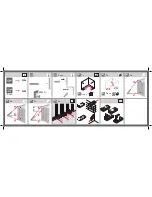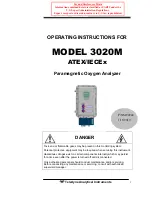
FLIR
CM85
USER
MANUAL
Document
Identifier:
CM85
‐
en
‐
US_AB
23
10.
One
of
the
following
results
is
displayed:
11.
123
indicates
clockwise
or
forward
rotation,
which
means
that
the
presumed
phase
line
1
is
ahead
of
the
presumed
phase
line
2.
12.
321
indicates
counterclockwise
or
reversed
rotation,
which
means
that
the
presumed
phase
line
2
is
ahead
of
the
presumed
phase
line
1.
13.
‐ ‐
means
that
the
meter
is
unable
to
determine
the
results.
14.
Lo
V
means
that
users
possibly
removed
the
test
leads
before
completing
the
testing
procedure.
To
repeat
the
test,
press
the
OK
button
again.
5.9
Resistance
Measurements
Warning:
Do not do diode, resistance or continuity tests before you have removed the power from
capacitors and other devices under test during a measurement. Injury to persons can occur.
1.
Set
the
function
switch
to
the
position.
2.
Ensure
that
the
meter
is
set
to
resistance
measurement.
If
the
or
the
indicator
is
displayed,
press
the
MODE
button
repeatedly
until
none
of
these
indicators
are
displayed.
3.
Insert
the
black
probe
lead
into
the
negative
COM
terminal
and
the
red
probe
lead
into
the
positive
Ω
terminal.
4.
Touch
the
tips
of
the
probe
across
the
circuit
or
component
under
test.
5.
Read
the
resistance
value
on
the
display.
5.10
Capacitance
Measurements
Warning:
Do not do capacitance tests before you have removed the power the capacitor or other
devices under test during a measurement. Injury to persons can occur.
Note:
To
protect
the
internal
components,
if
a
capacitor
that
is
being
tested
has
a
charge,
the
meter
will
first
discharge
the
cap
and
show
diSC.
After
a
complete
discharge
the
meter
will
conduct
a
normal
test.
diSC
may
also
be
displayed
if
the
incorrect
input
is
provided
(e.g.,
measuring
voltage
while
in
capacitance
mode).
1.
Set
the
function
switch
to
the
position.
2.
Insert
the
black
probe
lead
into
the
negative
COM
terminal
and
the
red
probe
lead
into
the
positive
terminal.
3.
Touch
the
tips
of
the
probe
across
the
part
under
test.
4.
Read
the
capacitance
value
on
the
display.
Note:
For very large capacitance values, it may take several seconds for the measurement to
settle and the final reading to stabilize.
















































